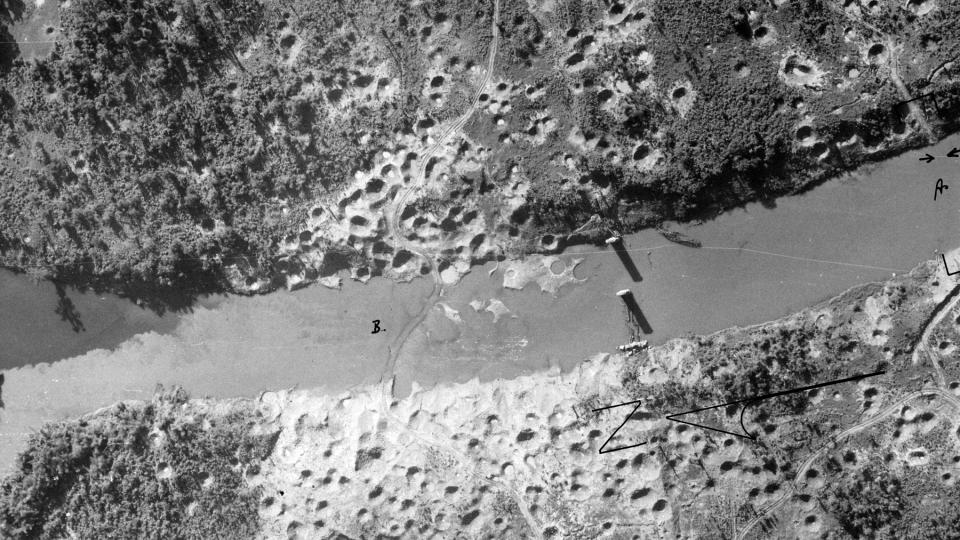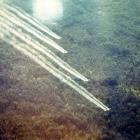The term “ecocide” was first used during the Vietnam War to describe the deliberate targeting of the environment in conflict. Many of the environmentally damaging technologies devised by the US aimed at disrupting the Ho Chi Minh Trail, the labyrinthine network of paths that moved people and material from North Vietnam to fighting in the South. These included the first widespread use of chemical herbicides in war, sprayed from C-123s to deny cover to enemy troops, and the first martial application of weather modification technologies, seeding clouds to create torrents of rain to bog down combatants. Revisiting the Trail reveals how the opposing sides harnessed nature’s agency in contrasting ways that made a significant difference to the war’s outcomes.

UC-123 airplanes spraying herbicides in central South Vietnam, 1966.
UC-123 airplanes spraying herbicides in central South Vietnam, 1966.
Unknown photographer, 1966.
Courtesy of the National Museum of the US Air Force.
 This work is licensed under a Creative Commons Public Domain Mark 1.0 License.
This work is licensed under a Creative Commons Public Domain Mark 1.0 License.
The North Vietnamese Army used landscapes strategically for concealment, while the US forces needed visibility to understand their enemy’s plans. The Trail was the penultimate example of this strategy: it zigzagged thousands of kilometers through high mountain peaks to wet muggy jungles to open dusty plains, clandestinely moving nearly a million solders and vast amounts of supplies to bolster communist-affiliated forces in the South. Although the name conjures up a vision of a single jungle path, the Trail was in fact a complicated network of roads, bridges, supply chains, and storage depots that shifted over time and space.
An elite military group in North Vietnam, which came to be known as Unit 559, set out to survey a way leading South starting in 1959. They followed the motto: “walk without footprints, cook without smoke, communicate without sound” (đi không dấu, nấu không thấy, nói không tiếng). Members of Unit 559 delivered food and munitions between way stations in a human chain, averaging around six miles a day on foot in 1960. Backpacks soon gave way to push bicycles with panniers, increasing speed and weight carried to 700 pounds apiece. The weather dictated work and movement, as 70 percent of the annual rain fell in just a few months: the fall monsoon was a time of rest and stockpiling, while the dry season was a rush down the now passable paths. As a North Vietnamese commander noted, “Time in the dry season is calculated by the hour.”

Land damage in Laos from US bombing of the Ho Chi Minh Trail.
Land damage in Laos from US bombing of the Ho Chi Minh Trail.
Unknown photographer, n.d.
Courtesy of the National Museum of the US Air Force.
 This work is licensed under a Creative Commons Public Domain Mark 1.0 License.
This work is licensed under a Creative Commons Public Domain Mark 1.0 License.
Starting in 1963, the Trail shifted westward through Laos, which could handle motorized traffic. The North Vietnamese Army found ingenious ways to disguise their movements: they would hang baskets of potted plants along open trails in sparse areas, tie heavy rocks to bamboo branches to bend them down across roads like a tunnel, or in some places, whole new forests were deliberately planted along roadsides. The general in charge said his goal in developing the expanded Trail was to take advantage of “weather, terrain, and harmony among our people” (thiên thời, địa lợi, nhân hoà). By the mid-1960s, thousands of miles of terrain could handle hundreds of trucks a day.

Poster on the 50th Anniversary of the Ho Chi Minh Trail: “Always Green Truong Son” (Truong Son is the mountain range through which the Trail ran).
Poster on the 50th Anniversary of the Ho Chi Minh Trail: “Always Green Truong Son” (Truong Son is the mountain range through which the Trail ran).
Poster by Ha Huy Cuong and Hai Duong, 2009.
 This work is licensed under a Creative Commons Public Domain Mark 1.0 License.
This work is licensed under a Creative Commons Public Domain Mark 1.0 License.
Because President Johnson had ruled out combat forces in Laos, the US military campaign to stop the Trail was primarily carried out from the air, resulting in the largest aerial interdiction effort in human history. The US relied on “geographical intelligence,” including the work of soil scientists who created tractionability maps for southern Laos to understand the seasons and places where vehicles could move. Starting in 1965, US air strikes aimed at slowing supply movement by bombing bridges and way stations. Other approaches included Operation Ranch Hand to extensively spray herbicides to expose jungle cover. By mid-1966 it was estimated that 1,500 km of roads had been doused with 200,000 gallons of herbicides, and many key routes and passes were heavily defoliated. Another scheme, codenamed Project Commando Lava, aimed to destabilize soils on the Trail; paper sacks filled with secret chemical concoctions were thrown from aircraft for several months, to little avail. A further scheme of weather modification known as Operation Popeye from 1967–1972 laced high clouds with silver iodide to create rain to slow down the traffic on the Trail.
Ultimately, the deadly cat and mouse games along the Trail—with one side covertly trying to expand roads and the other side trying to block them—were shaped by nature’s agency in ways that favored the North. North Vietnamese leaders strategically exploited both weather and local environments to expose weaknesses in the US’s aerial perspective and achieved the goal of moving large amounts of personnel and material to the South. The inability of the US, given their reliance on airpower, to read and use landscapes in the same way put them at a permanent disadvantage, which not even new technologies could overcome. In the end, the North’s close-to-the-ground strategy succeeded, although it came at a great human and environmental cost.
In the post-war years, the various routes of the Trail fell mostly into disuse, and post-war impacts were only haltingly addressed. UXO-studded fields still regularly kill and maim unsuspecting farmers and children in both Vietnam and Laos. Dioxin reservoirs persist in soil, particularly around former US air bases. Long-term remediation of these sites has only begun in the last few years, indicating the scale of challenges to ameliorate environmental impacts of warfare. And notwithstanding valiant efforts of many international lawyers, and despite the terrible example of Vietnam, ecocide is still not recognized as a prohibited activity during conflict.
How to cite
McElwee, Pamela. “The Origins of Ecocide: Revisiting the Ho Chi Minh Trail in the Vietnam War.” Environment & Society Portal, Arcadia (Spring 2020), no. 20. Rachel Carson Center for Environment and Society. https://doi.org/10.5282/rcc/9039.
ISSN 2199-3408
Environment & Society Portal, Arcadia
 This work is licensed under a Creative Commons Attribution 4.0 International License.
This work is licensed under a Creative Commons Attribution 4.0 International License.
2020 Pamela McElwee
This refers only to the text and does not include any image rights.
Please click on the images to view their individual rights status.
- Biggs, David. Footprints of War: Militarized Landscapes in Vietnam. Seattle: University of Washington Press, 2018.
- Nguyen, Trien T. “Environmental Consequences of Dioxin From the War in Vietnam: What Has Been Done and What Else Could Be Done?” International Journal of Environmental Studies 66, no. 1 (2009): 9–26.
- Hupy, Joseph. “The Environmental Footprint of War.” Environment and History 14 (2008): 405–21.
- Martini, Edwin. Agent Orange: History, Science, and the Politics of Uncertainty. Amherst: University of Massachusetts Press, 2012
- McElwee, Pamela. Forests are Gold: Trees, People, and Environmental Rule in Vietnam. Seattle: University of Washington Press, 2016.
- Westing, Arthur H. Environmental Consequences of the Second Indochina War. Stockholm: Almqvist and Wiksell, 1976.
- Zierler, David. The Invention of Ecocide: Agent Orange, Vietnam, and the Scientists Who Changed the Way We Think About the Environment. Athens: University of Georgia Press, 2011.















